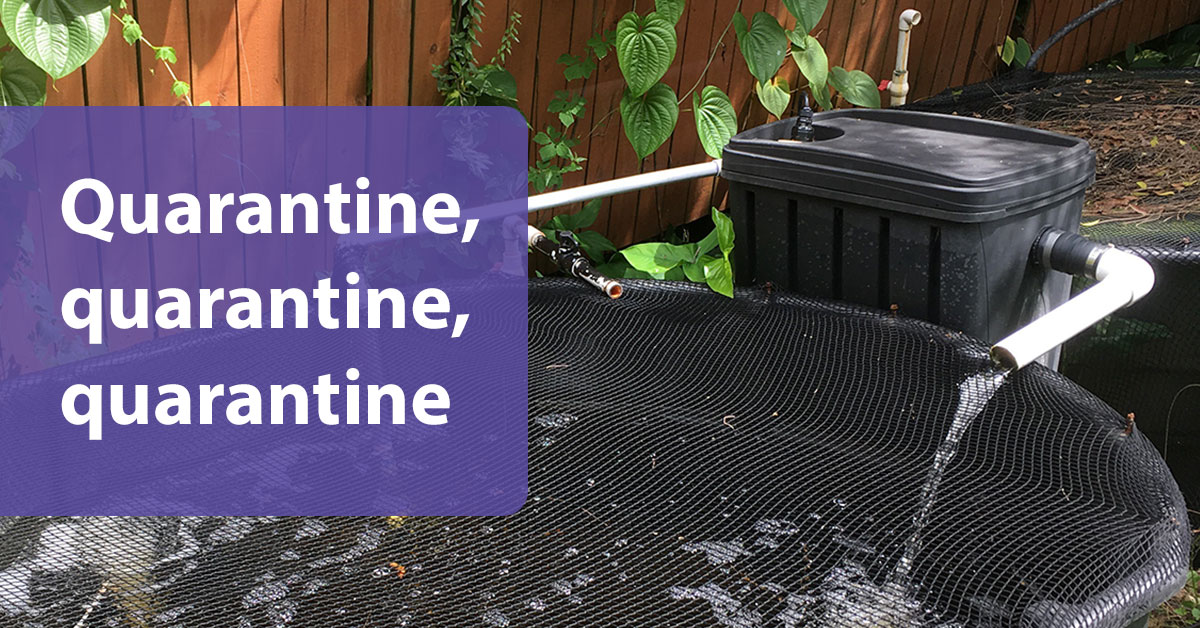
You have probably heard the phrase “Location, location, location”, often quoted by real estate agents.
In the Koi world, we say “Quarantine, quarantine, quarantine.” This should be rule #1, but it is often the most overlooked by koi owners. We want to stress the importance of good quarantine skills and will be covering how to setup your koi quarantining tank. You can also click to jump right to our recommended koi quarantine kits.
In this article, we’ll cover these essential koi quarantine questions:
- Why do I need to quarantine Koi?
- What might happen if I do not quarantine?
- How do I setup a koi quarantine tank?
- What are important tips for koi quarantine procedures?
- What are your recommended koi quarantining products?
Why is it so important to quarantine new Koi in a tank?
Imagine you just got a beautiful new Koi.
You are excited to see and feed the new Koi in your pond.
But wait!
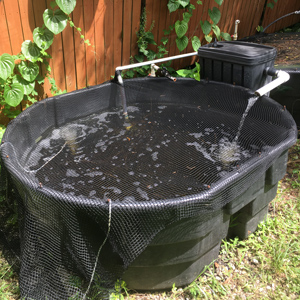 Do not introduce the new Koi to your pond yet. Keep the new Koi in a separate tank and monitor it for several weeks.
Do not introduce the new Koi to your pond yet. Keep the new Koi in a separate tank and monitor it for several weeks.
It is critical to quarantine any new Koi from other ponds because the newly purchased Koi may carry parasites, bacteria, fungi, or viruses.
Your Koi providers, whether you buy Koi from your friends or a store, did their best to eliminate them; but all it takes is to overlook an unhatched egg of a parasite, which is microscopic. You do not want it to break out in your main pond and make all your other Koi sick.
Even if if a new Koi is all clean and healthy, it is often exhausted and stressed from the journey to your home, especially if it is shipped overnight from a dealer. It is usually weak from the trip and has low immunity. So if introduced to the main pond too soon, it could get infected from something that your other current Koi are already immune to.
In short, the purposes of quarantining are to:
- protect your current Koi in the main pond
- nurse the new Koi back to full health before it dives into your main pond
What might happen if I do not quarantine?
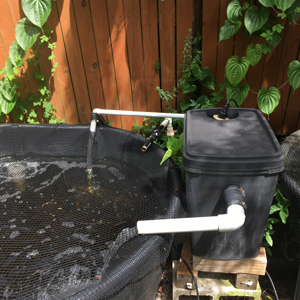 If you deal with a few dealers that you trust, most of the time, nothing may happen when you introduce a new Koi to your pond.
If you deal with a few dealers that you trust, most of the time, nothing may happen when you introduce a new Koi to your pond.
But 1 out of 100 purchases, a new Koi may come with an egg of a parasite in tow.
If it hatched in your main pond, your other Koi will feel itchy and start scratching themselves. If you catch the symptoms early enough, treating them is easy, but if you are late to react, it will worsen into a secondary bacterial infection from the scratching. And this new infection will spread to other Koi.
Whether a secondary infection or not, once infections spread, not only will it be more difficult to treat, but it may also damage your Koi’s beauty. The worst is if a Koi should happen to carry KHV (Koi Herpes Virus), you might potentially lose your whole collection of Koi.
I do not mean to scare you, but do want to inform you about the serious hazards to your pond without a protective quarantine process!
Learn how to treat sick Koi – Read How to Make Medicated Koi Food for Bacterial Infections
How To Setup Koi Quarantine Tank System
These quarantine items help protect your koi from outside invaders and disease.
To set up a quarantine tank, see the illustration above showing a completed setup.
You can use the following lists to ensure your quarantine tank and accessories are complete.
Quarantine Essentials:
Quarantine Accessories:
- water thermometer
- test kit for ammonia, nitrite, and pH
- salt meter
- salt
- ClorAm-X (dechlorinator and ammonia binder)
- Koi Prazi
- Ich-X water treatment
- heater
5 Koi Quarantine Procedure Tips
As you can see by now, a good quarantine procedure is a life line in this hobby.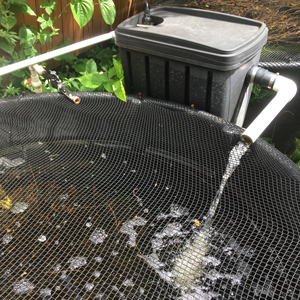
To fully enjoy the hobby, you need to learn how to play it safe.
Setting up a quarantine system is pretty simple. You can set up a temporary version without a filter or a more permanent version with filter system. Either version will do the job, but you need to keep the following in mind.
1. Check water parameters constantly
Quarantine tanks are usually much smaller than your regular ponds and therefore water parameters can change very quickly, especially if you use a temporary version with no filter. For a quarantine tank with no filter, I recommend you feed no or very little feeding. Feeding will increase ammonia and nitrite level and you will be forced to change water often. If you feed, I recommend Manda Fu Koi Food.
2. Manage water temperature
Keeping water temperature warm is another important quarantine tip.
Your Koi’s immune system works the best when water is over 70° F. At this temperature, they can more quickly recover from the stress and exhaustion of the journey to a new environment. It is also important because the most dangerous disease in Koi hobby, KHV (Koi Herpes Virus), appears only in warm water temperatures. And it takes about 2 weeks to break out if there is any.
3. Add a small Koi from your pond
This is also a good way to tell if the new addition to your pond may cause any issues.
If new Koi carry any bugs, it should affect this Koi. Or vise versa. Koi in your pond may carry something but already immune to it. If your new Koi are not immune to it, you will see the problem in the quarantine tank. So the Koi plays the role of a canary in coal mine. Plus, Koi are social animal. They always do better when they have companions. It will help new Koi adapt to the new environment.
If you set up a more permanent quarantine tank with filter, these canary Koi will keep your biological filter going.
4. Get advice, (but…)
This is not just in quarantine, but Koi hobby in general. If you observe something unusual, don’t panic.
First check all the water parameters such as water temp, ammonia, nitrite, pH. Then, pick up your phone and call your dealer for advice. You may have many dealers and friends to talk to, but at many times, listening to many and trying to do everything make the situation worse. Stick to a few experienced sources to keep advice consistent
5. Quarantining new Koi is your responsibility
As the owner of your beloved and beautiful Koi, it is your responsibility to quarantine new Koi and protect your precious collections.
Often, I am asked if it is OK to introduce new Koi direct to a pond. As a koi dealer and also a koi lover, I can not and should not say “Yes you can.” You should always quarantine new Koi. As a dealer of Japanese koi for sale, I do everything I can to provide clean and healthy Koi, but dealers including myself should not be over-trusted.
Again, it is only you who can protect your existing Koi and safely introduce a new family member to your pond.
Recommended DIY Koi Quarantine Products For Sale
To make quarantining your koi easier, we created the Quarantine Tank Kit and Quarantine Accessory Kit to get all the products you need at one time. They are high quality products and the kits are cheaper than buying them individually!
Quarantine Tank Kit – Premium
Quarantine Tank Kit
Several variations are available with prices ranging from $849.00 – $1,189.00.
Click to view on our supply website
Quarantine Tank Accessories
Quarantine Accessory Kit
This is a great way to start your koi medicine cabinet with price at $249.
Click to view on our supply website
The quarantine kit is a necessary tool for all koi hobbyists and owners. It is strongly recommended that every Kodama Koi purchased be quarantined before adding to an aquarium or pond.
We want to see your new koi thriving in it’s new environment!
How do you Quarantine New Koi into a Tank?
Once you receive a new Koi, please release it in a separate quarantine tank.
Then follow these abridged instructions:
- Add 3 lb salt/100 gal water to your quarantine tank (0.3% salinity)
- Observe the new Koi carefully to assure it does not develop disease for 14–21 days
- If your quarantine tank has a filter, please feed the Koi lightly. Manda Fu is ideal.
- If your quarantine tank has no filter, you may still feed them lightly, but do a partial water change every 2–3 days (about 25%). Add salt to maintain 0.3% salinity.
- After 3–5 days, if the Koi looks well, you may use Koi Prazi and Ich-X to deal with any potential parasites
- Throughout the quarantine, check the pH, ammonia, and nitrite levels regularly
- Maintain a water temperature of 65–78 F, ideally 70+ F.
Read More Koi Quarantine Tips
Use this guide to properly introduce new koi fish into your pond using the proper quarantining, pond care, and water quality control methods for good husbandry in koi care after receiving fish.
Based on our Japanese breeders and koi farm, these techniques are what work best when receiving Kodama koi but are also good tips for any koi pond owner adding more koi to their pond. Click the button to read more tips on quarantine and fish care!

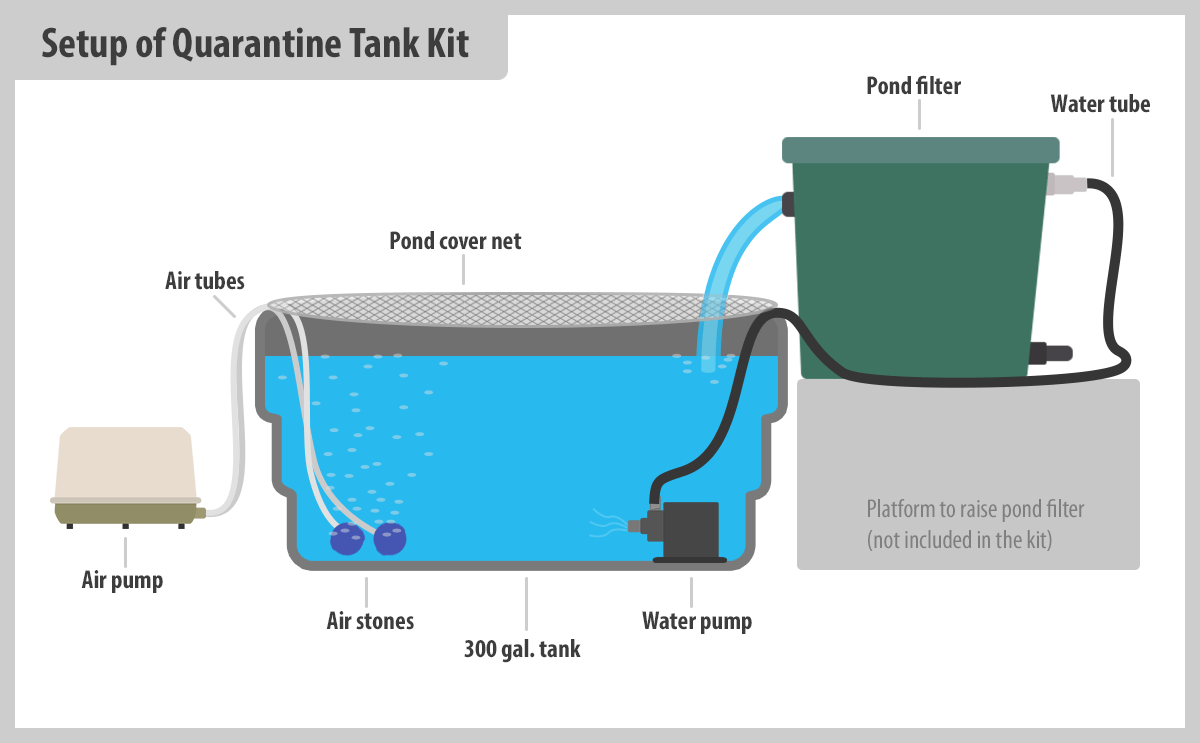
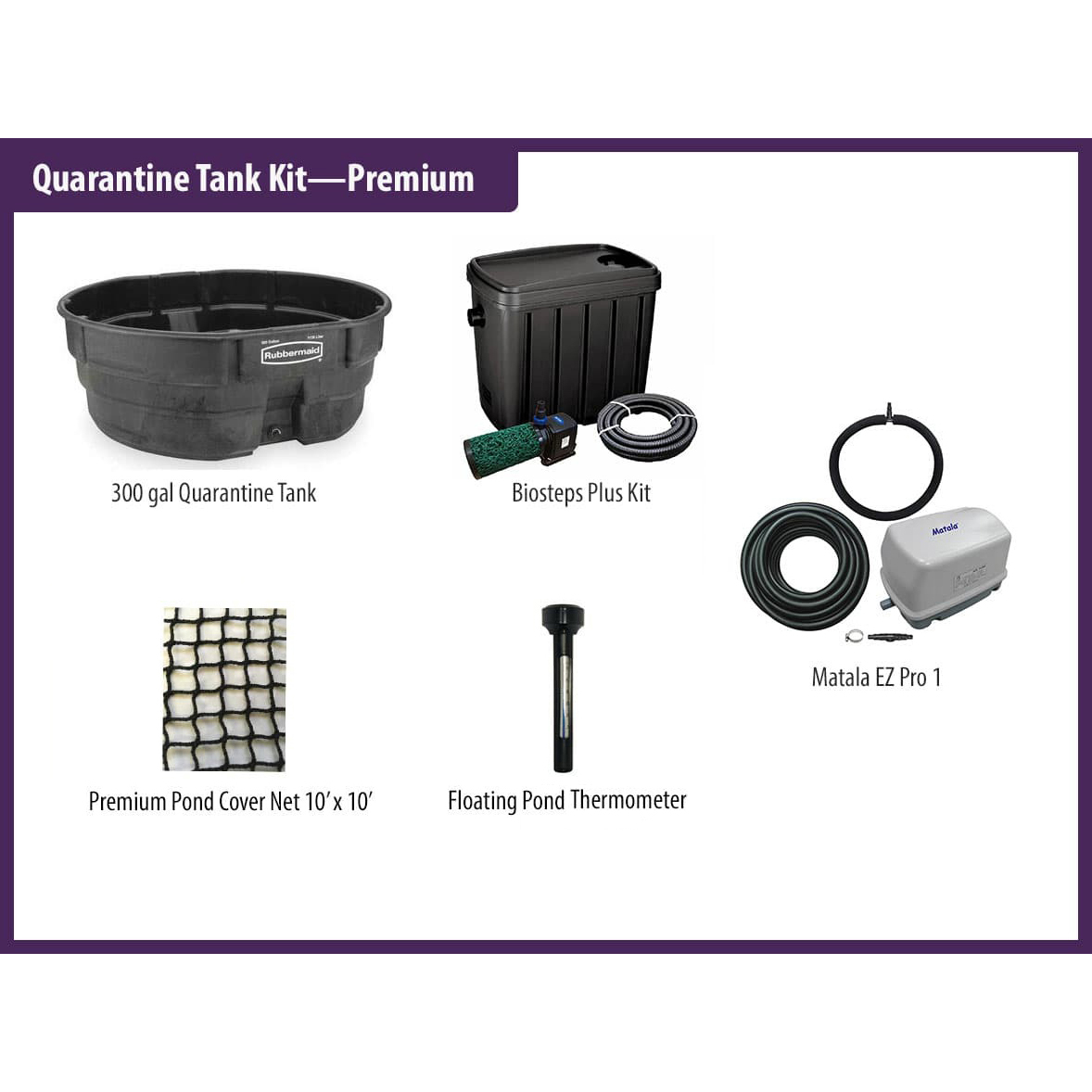
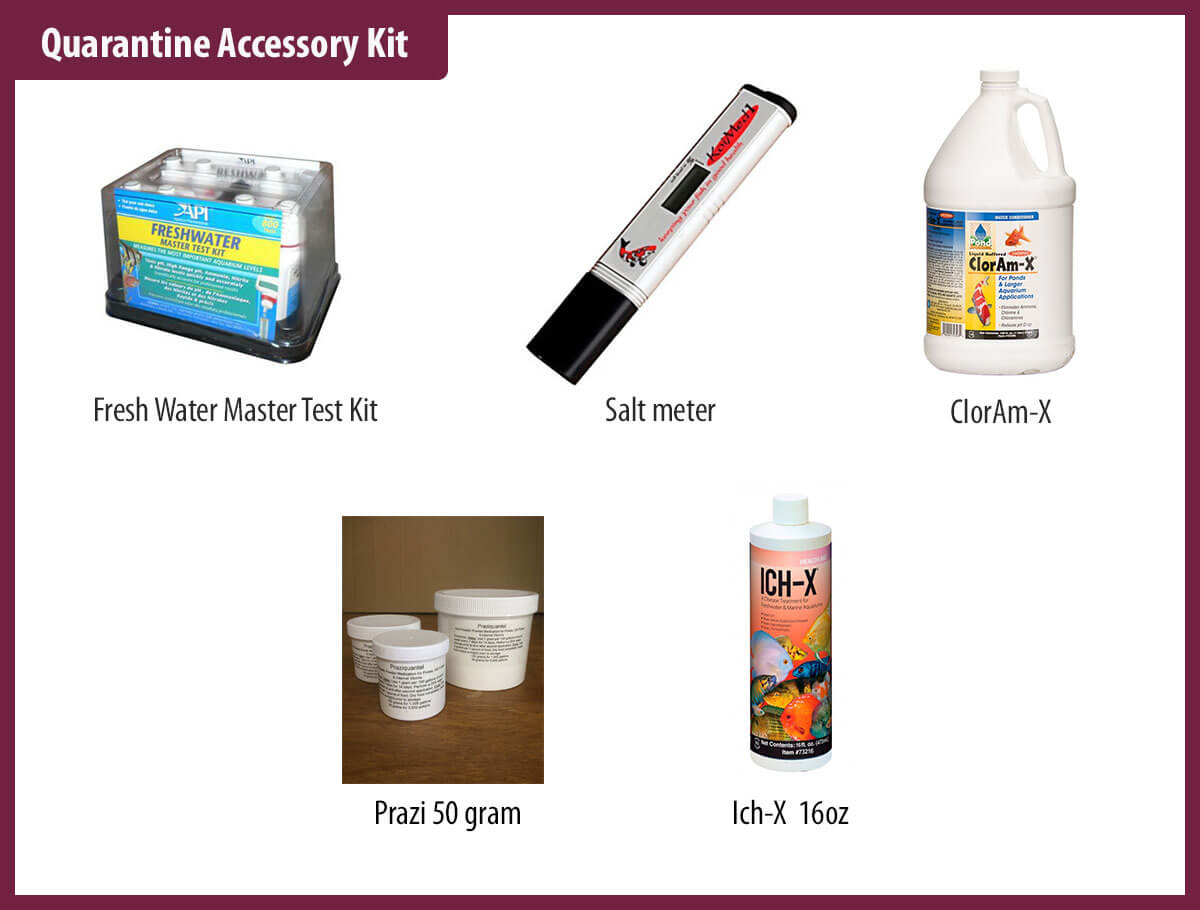
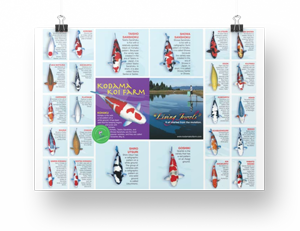

What do you do if you identify what appears to be a sick koi – – what does a sick koi look like?
Thank you for your question Felipe. This article about koi health has a checklist to diagnose symptoms and will discuss more about what to do if your koi appears sick – https://www.kodamakoifarm.com/koi-sick-health-diagnosis-symptoms-diseases/
I have a koi that is showing signs of having.Dropsy how long should I keep it in a quarantine tank and do koi recover from this condition.My koi eats and is active.looking for some advice
Dropsy is hard to treat, but I would keep it until it completely heals.
Help! I have a nice healthy pond with about 40 koi – some are 3-4 pounds.
We added a plecostamus to eat algae a while back.
Problem – thousands of little black guppies (?) have hatched and invaded the pond. They seem to be hatching more at an incredible rate. It’s out of control the amount of fry in our pond. What do I do?
It’s a good practice to keep Koi as a single species in the pond, mostly because the chemical remedies required to treat them can be harmful to other species!
I would imagine if your water is clear enough that a lot of the eggs and fry will get eaten, particularly if you reduce your feeding but inevitably some are likely to survive and once over a certain size will be ignored by your Koi!
At this point you will need to net them out and put into a holding tank and see if any of your local aquatic stores would be interested in taking them.
Usually they do as it’s free stock for them!
Drain the holding tank down to make them easier to catch, bag them and take to the store quickly as I doubt you have oxygen and will need to rely on the air you will be able to trap in the bags!
Good luck!
Hello can you put koi fry in a fish tank with heater air stones filters 36x30x15 thank steve UK